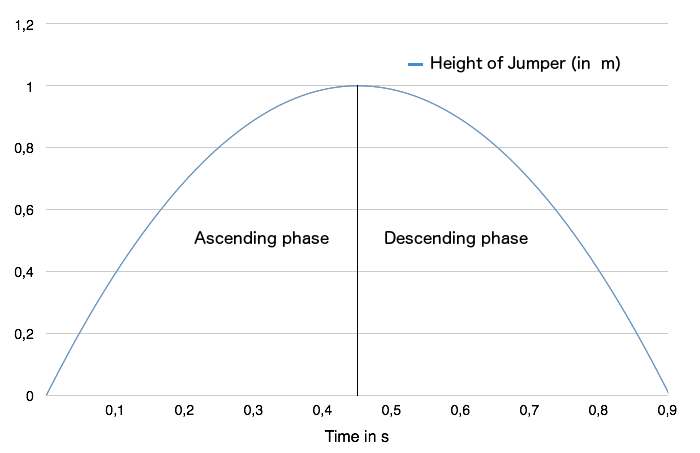The vertical jump test is a common test of leg power. An understanding of the physics of the vertical jump can help you maximize your jump height. It is also useful knowing the physics to understand the formula used to calculate jump height from the time of the jump, one of the several methods you can use to measure vertical jump height.
Projectile Motion
The human body is no different to any other object, and must follow the laws of physics, and when jumping, Newton's laws of motion apply.
To reach a maximum jump height an athlete tries to vertically accelerate his body as fast as possible. Once the jumper leaves the ground it is not possible to further increase velocity and therefore jump height is predetermined at this point.
Starting with the takeoff, the acceleration of earth gravity will slow down the movement of the jumper until velocity reaches zero at the peak of the jump. After that, the downward motion will be accelerated by gravity until landing. Therefore a vertical jump consists of two phases, the ascending phase and the descending phase.
It can be shown that both of these phases take the same time, with the peak of the jump happening at exactly the midpoint of hang time. The following graph shows the plane of flight of an athlete:
Graph: Plane of flight of a vertical jump

The graph shows that the downward movement of the jump takes half of the overall time of the jump and velocity at the peak of the jump is zero. Therefore it is easiest to calculate the jump height by identifying the distance traveled by a physical body which is accelerated by earth gravity for a time which is equal to half the measured hang time:
distance traveled = initial velocity * time + ½ acceleration * time2
==> 0 + ½ * 9.81 m/s2 (hang time / 2)2
(* with 9.81 m/s2 being the earth acceleration which is almost constant on the earth surface)
The Effect of Arm Movements
By the effective swinging of the arms you can get greater jump heights. The arm swing helps jump performance through increasing the center of gravity at take off, and also by increasing take off velocity (Lees et al. 2004). As your arms swing up, there is an opposite reaction of the body being forced downward, increasing increasing the force you push off the ground.
The Effect of Bending the Legs
In addition to swinging the arms, there is a benefit from bending the legs prior to takeoff. You can easily test this yourself. By starting from the lower bent leg position the jump height would not be as great as when starting from a more upright position and bending the legs immediately before takeoff.
References
- Lees A, Vanrenterghem J, De Clercq D., Understanding how an arm swing enhances performance in the vertical jump. J Biomech. 2004 Dec;37(12):1929-40.
Related Pages
- Vertical Jump Power Calculations
- About Projectile Motion
- Calculating power during running
- Procedure for Vertical Jump Testing and using the Timing Mat method
- Vertical Jump test results.
- Converting vertical jump units between cm and inches.
- Vertical jump devices in the fitness testing store.
- About Force Plates


 Current Events
Current Events